U.S. Open, New York
August 25, 1980; 128 Draw (16 seeded) – $300,000; Surface – Hard
An injection of amazing self-confidence for John McEnroe. The 21-year-old American not only defended his title, but he did it in impressive style, overcoming in the last three matches his three toughest opponents, every one of them after demanding battles: Ivan Lendl (2:47 hrs), Jimmy Connors (4:16 hrs) and Bjorn Borg (4:13 hrs)! The tournament witnessed a 5-set encounter in semifinals between two biggest 5-set specialists of the Open era: Borg and Johan Kriek – the South African had a little experience in five-setters at the time though, his loss to Borg was just his fourth five-setter in career.
All scorelines
New York Times compilation
First round:
The fitness war began at the United States Open tennis championships yesterday. Even John McEnroe, the defending men’s champion, said he felt chills and heat at the same time from the stifling 90-degree temperature during a 6-3, 6-4, 6-1 victory over Christophe Roger-Vasselin of France. McEnroe joined Bjorn Borg and Vitas Gerulaitis among the seeded players who survived 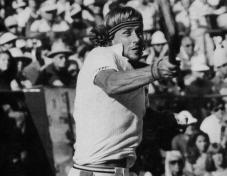 opening tests with straight-set triumphs. Borg, seeded No. 1, benefited from mid-afternoon shade on the grandstand court and needed only 1 hour 21 minutes to eliminate Guillermo Aubone of Argentina, 6-1, 6-4, 6-1. Then he said his right knee ”isn’t bad at all, no soreness at all.’ ‘This was just a warmup,” said Borg, the five-time Wimbledon champion who has never won this tournament and has had a knee problem in recent weeks, ”Every other match after this will be tough.’‘ He next faces John Sadri, a big-hitting American who served 10 aces in a four-set decision over Joao Soares of Brazil, 6-2, 4-6, 6-4, 6-4. The favorably sunny conditions lured a record opening-day crowd of 12,338 to the National Tennis Center. Mel Purcell, 21, the surprise runner-up at the recent United States clay championships, was too fit and steady for 33-year-old Stan Smith. Purcell won, 7-6, 6-4, 6-0. ”I haven’t played much this summer and I guess it showed,” said Smith, who committed 12 double faults, ”He kept a lot of balls in play and made me work.” Smith’s longtime doubles partner, Bob Lutz, suffered a setback last night that dampened his summer of rejuvenation. Outplaying eighth seeded Eddie Dibbs with sharply angled volleys and running forehand cross-court shots, the 32-year-old Californian led, two sets to love, and held 2 match points with the discouraged Dibbs serving at 3:5, 15/40. Dibbs recovered to duece. During a fierce exchange, Lutz, trapped in no man’s land, dived to make a backhand volley and landed on his right hand. In obvious pain, and with the crowd of 9,319 silently stunned, he lost 16 of the next 18 games and Dibbs escaped, 5-7, 2-6, 7-5, 6-0, 6-2! Afterward, Lutz told Dr. Irving Glick, the tournament physician, that the pain in the fingers of his right hand during the last three sets might have resulted from cramps rather than the fall. Vincent Van Patten bowed to Gerulaitis, 6-3, 6-4, 6-0, in the opening match in the stadium. ”He’s in great shape and he hit some great shots,” Van Patten said of Gereulaitis, who will face a formidable second-round opponent, Hank Pfister. Youth seemed to prevail in the 3-hour-50-minute, five-set match between Van Winitsky, 21, and Jaime Fillol, 34. Fillol served for 4:0 in the fifth set, only to lose in a tiebreaker, 5-7, 7-5, 3-6, 6-3, 7-6. Two other matches, Bill Scanlon–John Feaver (2-6, 4-6, 6-3, 6-3, 7-6) and Peter Feigl–Dominque Bedel (6-4, 4-6, 6-7, 7-6, 7-6), also went to fifth-set tiebreakers, with Scanlon and Feigl affirming their rankings with victories, although Feaver served for the match at 5:3. Nick Saviano, who had emerged as tennis’s marathon man and reached the last 16 at Wimbledon, after losing two sets easily, had to retire in the third set against Andres Gomez because of an ailing ankle. Gene Mayer and Jose-Luis Clerc were eliminated in the afternoon. Jimmy Connors has an easy night’s work as he made his debut with a 6-2, 6-2, 6-2 triumph over Marcel Freeman, a 19-year-old collegian who was a ball boy for Connors four years ago in his Open title match. Yesterday was a family day of sorts at the National Tennis Center, with names such as Giammalva, Jaeger, Gottfried and even a Borg popping up. But there is only one Nastase here – Ilie – and he was fined $750 for an obscene gesture in hitting a linesman with a ball during a four-set victory over Patrice Dominguez of France, 6-4, 6-1, 4-6, 6-2. The Mayer on the grandstand court during the day was Gene, seeded sixth here and on the computer rankings. The day before the Open, his older brother, Sandy, withdrew with an injury. Yesterday, leading two sets to one and at 2:3 in the fourth against Gianni Ocleppo of Italy, Gene Mayer went wide for a ball, planted his left foot and ”felt something go.” What went was a left hamstring muscle, a chronic problem that has required more rest than Mayer has given it in recent months. Under the strain of hot, hard courts and humid temperatures that reached 98 degrees by late afternoon, Mayer was forced to retire at 6-2, 6-2, 6-7, 2-4. ”It’s a weakness, a tight muscle, and it tends to go,” said Mayer, the highest seeded player to fall in the first two days. Clerc, seeded No. 12, was ousted by Bernie Mitton of South Africa, 6-3, 6-2, 4-6, 2-6, 7-5. ”Playing on center court was a good thing,” Mitton said after the 3-hour-23-minute match. ”It pumped me up and got me going. If we had played on an outside court, he might have beaten me in straight sets.” The proudest person on the premises yesterday may have been Sammy Giammalva Sr. One day after his son Tony had taken his opening match in the tournament, Sammy Jr. made an impressive debut, with father only too happy to cart his son’s bags back to the locker room. ”It’s pretty neat, we both did it together,” Sammy Jr., who is 17 years old and America’s national junior champion, said after his 3-6, 6-1, 6-2, 6-2 victory over Rick Fisher. Among seeded players, Harold Solomon, fresh from a Grand Prix tournament triumph last weekend in Cincinnati, ousted Jan Norback, 6-2, 6-4, 6-4. Solomon, who next plays Nastase, has shown remarkable maturity in recent months on and off the court, perhaps as a result of his new role as president of the Association of Tennis Professionals. Confidence has always been one of Brian Gottfried‘s problems. Even after beating David Carter, 6-7, 6-2, 6-1, 6-3, on the stadium court, Gottfried, who reached the semifinals at Wimbledon as an unseeded player, said he was still trying to shake his tendency to think ”negatively.” The kids were cleaning up yesterday: 16-year-old Jimmy Arias, the youngest player ever to win a US Open match, beat a qualifier, Fred Sauer of South Africa, 6-2, 6-7, 6-2, 6-2. ”He’s like my son,” said Nick Bolletieri. The financing of Arias’s career is shouldered by a sponsor, Louis Marx Jr., of the toy manufacturing company. ”He’s been a big believer in Jimmy,” Bolletieri mentioned. ”We’re probably 18 months away. If he grows another three inches or so, we have potentially a fine player.” (Arias’ record will be overcome 7 years later by Michael Chang). First round match won also 13 months older than Arias, Thierry Tulasne, who was lucky because his opponent, Tom Leonard retired while leading. Tulasne won 2-6, 6-6 ret.
opening tests with straight-set triumphs. Borg, seeded No. 1, benefited from mid-afternoon shade on the grandstand court and needed only 1 hour 21 minutes to eliminate Guillermo Aubone of Argentina, 6-1, 6-4, 6-1. Then he said his right knee ”isn’t bad at all, no soreness at all.’ ‘This was just a warmup,” said Borg, the five-time Wimbledon champion who has never won this tournament and has had a knee problem in recent weeks, ”Every other match after this will be tough.’‘ He next faces John Sadri, a big-hitting American who served 10 aces in a four-set decision over Joao Soares of Brazil, 6-2, 4-6, 6-4, 6-4. The favorably sunny conditions lured a record opening-day crowd of 12,338 to the National Tennis Center. Mel Purcell, 21, the surprise runner-up at the recent United States clay championships, was too fit and steady for 33-year-old Stan Smith. Purcell won, 7-6, 6-4, 6-0. ”I haven’t played much this summer and I guess it showed,” said Smith, who committed 12 double faults, ”He kept a lot of balls in play and made me work.” Smith’s longtime doubles partner, Bob Lutz, suffered a setback last night that dampened his summer of rejuvenation. Outplaying eighth seeded Eddie Dibbs with sharply angled volleys and running forehand cross-court shots, the 32-year-old Californian led, two sets to love, and held 2 match points with the discouraged Dibbs serving at 3:5, 15/40. Dibbs recovered to duece. During a fierce exchange, Lutz, trapped in no man’s land, dived to make a backhand volley and landed on his right hand. In obvious pain, and with the crowd of 9,319 silently stunned, he lost 16 of the next 18 games and Dibbs escaped, 5-7, 2-6, 7-5, 6-0, 6-2! Afterward, Lutz told Dr. Irving Glick, the tournament physician, that the pain in the fingers of his right hand during the last three sets might have resulted from cramps rather than the fall. Vincent Van Patten bowed to Gerulaitis, 6-3, 6-4, 6-0, in the opening match in the stadium. ”He’s in great shape and he hit some great shots,” Van Patten said of Gereulaitis, who will face a formidable second-round opponent, Hank Pfister. Youth seemed to prevail in the 3-hour-50-minute, five-set match between Van Winitsky, 21, and Jaime Fillol, 34. Fillol served for 4:0 in the fifth set, only to lose in a tiebreaker, 5-7, 7-5, 3-6, 6-3, 7-6. Two other matches, Bill Scanlon–John Feaver (2-6, 4-6, 6-3, 6-3, 7-6) and Peter Feigl–Dominque Bedel (6-4, 4-6, 6-7, 7-6, 7-6), also went to fifth-set tiebreakers, with Scanlon and Feigl affirming their rankings with victories, although Feaver served for the match at 5:3. Nick Saviano, who had emerged as tennis’s marathon man and reached the last 16 at Wimbledon, after losing two sets easily, had to retire in the third set against Andres Gomez because of an ailing ankle. Gene Mayer and Jose-Luis Clerc were eliminated in the afternoon. Jimmy Connors has an easy night’s work as he made his debut with a 6-2, 6-2, 6-2 triumph over Marcel Freeman, a 19-year-old collegian who was a ball boy for Connors four years ago in his Open title match. Yesterday was a family day of sorts at the National Tennis Center, with names such as Giammalva, Jaeger, Gottfried and even a Borg popping up. But there is only one Nastase here – Ilie – and he was fined $750 for an obscene gesture in hitting a linesman with a ball during a four-set victory over Patrice Dominguez of France, 6-4, 6-1, 4-6, 6-2. The Mayer on the grandstand court during the day was Gene, seeded sixth here and on the computer rankings. The day before the Open, his older brother, Sandy, withdrew with an injury. Yesterday, leading two sets to one and at 2:3 in the fourth against Gianni Ocleppo of Italy, Gene Mayer went wide for a ball, planted his left foot and ”felt something go.” What went was a left hamstring muscle, a chronic problem that has required more rest than Mayer has given it in recent months. Under the strain of hot, hard courts and humid temperatures that reached 98 degrees by late afternoon, Mayer was forced to retire at 6-2, 6-2, 6-7, 2-4. ”It’s a weakness, a tight muscle, and it tends to go,” said Mayer, the highest seeded player to fall in the first two days. Clerc, seeded No. 12, was ousted by Bernie Mitton of South Africa, 6-3, 6-2, 4-6, 2-6, 7-5. ”Playing on center court was a good thing,” Mitton said after the 3-hour-23-minute match. ”It pumped me up and got me going. If we had played on an outside court, he might have beaten me in straight sets.” The proudest person on the premises yesterday may have been Sammy Giammalva Sr. One day after his son Tony had taken his opening match in the tournament, Sammy Jr. made an impressive debut, with father only too happy to cart his son’s bags back to the locker room. ”It’s pretty neat, we both did it together,” Sammy Jr., who is 17 years old and America’s national junior champion, said after his 3-6, 6-1, 6-2, 6-2 victory over Rick Fisher. Among seeded players, Harold Solomon, fresh from a Grand Prix tournament triumph last weekend in Cincinnati, ousted Jan Norback, 6-2, 6-4, 6-4. Solomon, who next plays Nastase, has shown remarkable maturity in recent months on and off the court, perhaps as a result of his new role as president of the Association of Tennis Professionals. Confidence has always been one of Brian Gottfried‘s problems. Even after beating David Carter, 6-7, 6-2, 6-1, 6-3, on the stadium court, Gottfried, who reached the semifinals at Wimbledon as an unseeded player, said he was still trying to shake his tendency to think ”negatively.” The kids were cleaning up yesterday: 16-year-old Jimmy Arias, the youngest player ever to win a US Open match, beat a qualifier, Fred Sauer of South Africa, 6-2, 6-7, 6-2, 6-2. ”He’s like my son,” said Nick Bolletieri. The financing of Arias’s career is shouldered by a sponsor, Louis Marx Jr., of the toy manufacturing company. ”He’s been a big believer in Jimmy,” Bolletieri mentioned. ”We’re probably 18 months away. If he grows another three inches or so, we have potentially a fine player.” (Arias’ record will be overcome 7 years later by Michael Chang). First round match won also 13 months older than Arias, Thierry Tulasne, who was lucky because his opponent, Tom Leonard retired while leading. Tulasne won 2-6, 6-6 ret.
Second round:
For the second time in three days, Ilie Nastase was fined for unsportsmanlike conduct at the United States Open yesterday, on an afternoon when the largest crowd in the tennis tournament’s history watched John McEnroe, Jimmy Connors, Martina Navratilova and Andrea Jaeger advance to the third round. Nastase was penalized 2 points in his 6-2, 6-2, 6-2 loss to Harold Solomon, and then he was fined $500 by the Grand Prix supervisor for throwing two tennis balls at the umpire. Wednesday, when Nastase beat Patrice Dominguez, he was fined $750 -$250 for an obscene gesture directed at an official and $500 for hitting a linesman with a batted ball. Apart from travel costs, Nastase’s brief appearance here has cost him $175; he has won $1,075 as a second-round loser and will pay $1,250 in fines for violating the code of conduct adopted by the Men’s International Professional Tennis Council five years ago. Nastase’s matches have been scheduled and supervised carefully to avoid a repeat of the 17-minute crowd disturbance that marked his evening match with McEnroe last year. He had requested a night date with Solomon to avoid the midday heat, but tournament officials apparently thought better of scheduling him after the cocktail hour. Nastase was annoyed that his request had not been honored, but he was even more piqued by what he called the uneven application of the conduct rules. ”I’m telling you, everybody’s swearing out there,” Nastase said. ”Nobody else gets fined. They look for my matches.” As is his fashion, Nastase became more argumentative and demonstrative after Solomon gained control. With Solomon leading 4:2 in the 2nd set, Nastase was assessed the first penalty point for delay of play. Solomon was leading 2:0 in the 3rd set when Nastase said he could not hear the calls because of airplane noise; he was penalized again for throwing the balls at the chair umpire. Afterward, the ever-playful Nastase suggested a new wrinkle in the disciplinary system, with fines levied according to which part of an umpire’s body a player hits. Before the last game, Nastase left the court to change his sweat soaked shorts, in preparation, he said, for a doubles match. He began to change 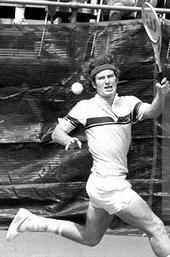 while still in view of some of the 20,226 spectators, but was urged, without a point penalty, to be more discreet. Nastase switched from white shorts to yellow ones in the referee’s office with an audience of two – Alan King, the comedian who is a regular at glamorous tournaments, and an old woman who, Nastase said, ”wasn’t too excited.” John McEnroe, the defending Open champion, has had his share of troubles, defaulting one post-Wimbledon tournament with a sprained ankle and losing in the first round of another. Yesterday, after beating Steve Krulevitz, 7-6(5), 6-0, 6-2, he said each match increased his confidence in his physical fitness. ”As you play more and get the feeling of how you’re going to react when you dive for a ball, it makes a difference,” McEnroe said. Jimmy Connors, fitter than McEnroe or Borg, is eager to add another even-numbered Open championship to his 1976 and 1978 titles. ”Maybe I’m the only one not injured,” he said after handling hard-serving Butch Walts, 6-3, 6-1, 6-3. ”I’m not just going out there and walking through it,” Connors said, dismissing the notion that the match had been a lark. ”Every time the ball comes back, I’m tested.” Vitas Gerulaitis was beaten by Hank Pfister in a fifth set tiebreaker last night. ”How does that jingle go – ‘I Love New York!’ ‘ Pfister said after holding off Gerulaitis’s comeback from a 2-0 deficit in sets before a crowd of 9,826 at the National Tennis Center. The scores were 6-3, 6-2, 3-6, 1-6, 7-6(6). “I always felt I could beat him, but I never had before” Pfister continued. ”We had played four times. To beat him in his backyard has to be the second-best win of my life. The best was Jimmy Connors in Vegas.” Joining Gerulaitis as seeded casualties were Eddie Dibbs, Peter Fleming and Regina Marsikova. Gerulaitis, loser to John McEnroe in last year’s final and enjoying one of his most productive seasons, seemed to be distracted early in the three-hour match, quibbling and finally shouting obscenities at the umpire. But the Kings Point, L.I., player, seeded fifth, scrambled back and appeared headed for victory when he led, 4:2, in the decisive tiebreaker. But Pfister, a 6-foot-4-inch Californian with a good serve-and-volley game, won four of the next five points. Gerulaitis saved one match point at 5:6 with a deep first serve. Serving at 6-all,
while still in view of some of the 20,226 spectators, but was urged, without a point penalty, to be more discreet. Nastase switched from white shorts to yellow ones in the referee’s office with an audience of two – Alan King, the comedian who is a regular at glamorous tournaments, and an old woman who, Nastase said, ”wasn’t too excited.” John McEnroe, the defending Open champion, has had his share of troubles, defaulting one post-Wimbledon tournament with a sprained ankle and losing in the first round of another. Yesterday, after beating Steve Krulevitz, 7-6(5), 6-0, 6-2, he said each match increased his confidence in his physical fitness. ”As you play more and get the feeling of how you’re going to react when you dive for a ball, it makes a difference,” McEnroe said. Jimmy Connors, fitter than McEnroe or Borg, is eager to add another even-numbered Open championship to his 1976 and 1978 titles. ”Maybe I’m the only one not injured,” he said after handling hard-serving Butch Walts, 6-3, 6-1, 6-3. ”I’m not just going out there and walking through it,” Connors said, dismissing the notion that the match had been a lark. ”Every time the ball comes back, I’m tested.” Vitas Gerulaitis was beaten by Hank Pfister in a fifth set tiebreaker last night. ”How does that jingle go – ‘I Love New York!’ ‘ Pfister said after holding off Gerulaitis’s comeback from a 2-0 deficit in sets before a crowd of 9,826 at the National Tennis Center. The scores were 6-3, 6-2, 3-6, 1-6, 7-6(6). “I always felt I could beat him, but I never had before” Pfister continued. ”We had played four times. To beat him in his backyard has to be the second-best win of my life. The best was Jimmy Connors in Vegas.” Joining Gerulaitis as seeded casualties were Eddie Dibbs, Peter Fleming and Regina Marsikova. Gerulaitis, loser to John McEnroe in last year’s final and enjoying one of his most productive seasons, seemed to be distracted early in the three-hour match, quibbling and finally shouting obscenities at the umpire. But the Kings Point, L.I., player, seeded fifth, scrambled back and appeared headed for victory when he led, 4:2, in the decisive tiebreaker. But Pfister, a 6-foot-4-inch Californian with a good serve-and-volley game, won four of the next five points. Gerulaitis saved one match point at 5:6 with a deep first serve. Serving at 6-all,  he pushed a backhand half-volley long. Pfister, whose computer ranking had slid to 40th, clinched on match point No. 2, when Gerulaitis drove a backhand wide. Gerulaitis’s practice partner, Bjorn Borg, won a strenuous second-round match over John Sadri although questions still lingered over Borg’s fitness. ”Right now, I don’t have any problems,” Borg said when asked if his tender right knee had flared up during his 7-5, 6-2, 2-6, 6-0 triumph. Borg next will play Peter McNamara of Australia, then possibly Yannick Noah of France and Roscoe Tanner. ”It sure didn’t look like it was bothering him in the fourth set,” said Sadri, who won only one point in Borg’s three service games in the set. ”I thought he was moving pretty well.” But there were times in the two-hour match when Borg did not appear to be moving with his customary quickness; he was not driving off his right foot on ground strokes or serving with pace and intensity. One reason might have been the heat. Borg and Sadri played on the asphalt-based Deco-Turf II court inside Louis Armstrong Stadium at the National Tennis Center, and the temperature reached 107 degrees during the match. Borg said he got ”a little tired” in the third set and that he has been receiving ”all kinds of treatment” daily for the knee. He denied intentionally serving out the third set at 2:5, a tactic that Vijay Amritraj said helped him survive the heat. Amritraj beat Eddie Dibbs, seeded eighth, 7-5, 0-6, 4-6, 6-2, 6-1. Jimmy Arias, the 16-year-old from Grand Island, N.Y., was not strong enough for Roscoe Tanner‘s thundering left-handed serve. Tanner scored a 6-3, 6-3, 6-0 second-round victory but said he was impressed with his young opponent. ”Over all, he’s going to be a very tough player,” Tanner said. ”He’s already tough.’‘ Peter Fleming, No. 9, was beaten handily by Johan Kriek of South Africa, 6-4, 6-2, 6-0, and Tony Giammalva made it three straight victories for his family by beating Leo Palin, 6-4, 6-2, 7-5. The ease with which Kriek, a 5-foot-7-inch South African, handled Fleming, who is 6’5, was surprising. In the first two sets, Fleming was good on only 50 percent of his first serves. ”He was so up for his serve, he forgot how to volley,” Kriek said. He kept Fleming off balance by alternating serves and volleys. Kriek, an unseeded player, appears at home on the hard courts. He has played well here in the past, victimized by the draw. He is continually paired with Vitas Gerulaitis, a player of similar style who is a shade better. Fleming is going through troubled times. He has lost in the early rounds at Grand Prix tournaments recently, jeopardizing his top-10 computer ranking. ”I was routed,” Fleming said, in one of his less-deprecating self-assessments. Fleming has had greater success in doubles, gaining confidence from his partner, John McEnroe. Dibbs was fortunate to escape in five sets on opening night when his opponent, Bob Lutz, got cramps. He was not so lucky against Amritraj, who has improved under the guidance of Roy Emerson, the former Australian professional. ”Working with Emerson helped me 50 to 60 percent,” Amritraj said after his 2-hour 27-minute victory. ”I always felt I had the game. I had to find somebody who could help me use it the right way.” Amritraj, 26th in the computer rankings, said that at 0:4 in the second set, he gave away the last two games. But he said his strategy was to make Dibbs work hard to win them. ”That could have made the difference in the fifth set,’‘ Amritraj said. ”He was much slower then.”
he pushed a backhand half-volley long. Pfister, whose computer ranking had slid to 40th, clinched on match point No. 2, when Gerulaitis drove a backhand wide. Gerulaitis’s practice partner, Bjorn Borg, won a strenuous second-round match over John Sadri although questions still lingered over Borg’s fitness. ”Right now, I don’t have any problems,” Borg said when asked if his tender right knee had flared up during his 7-5, 6-2, 2-6, 6-0 triumph. Borg next will play Peter McNamara of Australia, then possibly Yannick Noah of France and Roscoe Tanner. ”It sure didn’t look like it was bothering him in the fourth set,” said Sadri, who won only one point in Borg’s three service games in the set. ”I thought he was moving pretty well.” But there were times in the two-hour match when Borg did not appear to be moving with his customary quickness; he was not driving off his right foot on ground strokes or serving with pace and intensity. One reason might have been the heat. Borg and Sadri played on the asphalt-based Deco-Turf II court inside Louis Armstrong Stadium at the National Tennis Center, and the temperature reached 107 degrees during the match. Borg said he got ”a little tired” in the third set and that he has been receiving ”all kinds of treatment” daily for the knee. He denied intentionally serving out the third set at 2:5, a tactic that Vijay Amritraj said helped him survive the heat. Amritraj beat Eddie Dibbs, seeded eighth, 7-5, 0-6, 4-6, 6-2, 6-1. Jimmy Arias, the 16-year-old from Grand Island, N.Y., was not strong enough for Roscoe Tanner‘s thundering left-handed serve. Tanner scored a 6-3, 6-3, 6-0 second-round victory but said he was impressed with his young opponent. ”Over all, he’s going to be a very tough player,” Tanner said. ”He’s already tough.’‘ Peter Fleming, No. 9, was beaten handily by Johan Kriek of South Africa, 6-4, 6-2, 6-0, and Tony Giammalva made it three straight victories for his family by beating Leo Palin, 6-4, 6-2, 7-5. The ease with which Kriek, a 5-foot-7-inch South African, handled Fleming, who is 6’5, was surprising. In the first two sets, Fleming was good on only 50 percent of his first serves. ”He was so up for his serve, he forgot how to volley,” Kriek said. He kept Fleming off balance by alternating serves and volleys. Kriek, an unseeded player, appears at home on the hard courts. He has played well here in the past, victimized by the draw. He is continually paired with Vitas Gerulaitis, a player of similar style who is a shade better. Fleming is going through troubled times. He has lost in the early rounds at Grand Prix tournaments recently, jeopardizing his top-10 computer ranking. ”I was routed,” Fleming said, in one of his less-deprecating self-assessments. Fleming has had greater success in doubles, gaining confidence from his partner, John McEnroe. Dibbs was fortunate to escape in five sets on opening night when his opponent, Bob Lutz, got cramps. He was not so lucky against Amritraj, who has improved under the guidance of Roy Emerson, the former Australian professional. ”Working with Emerson helped me 50 to 60 percent,” Amritraj said after his 2-hour 27-minute victory. ”I always felt I had the game. I had to find somebody who could help me use it the right way.” Amritraj, 26th in the computer rankings, said that at 0:4 in the second set, he gave away the last two games. But he said his strategy was to make Dibbs work hard to win them. ”That could have made the difference in the fifth set,’‘ Amritraj said. ”He was much slower then.”
Third round:
At Wimbledon, the ritualistic beard belongs to Bjorn Borg, a five-time winner. As the first week of the United States Open tennis championships ended yesterday, Jimmy Connors had the fresh growth and positive attitude that could carry him to a fourth title. ”For the moment, I like it,” 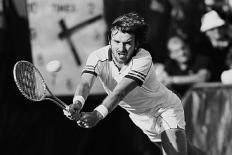 Connors said of his first beard, after he had made Terry Moor another straight-set victim, 6-4, 6-1, 6-1, and gained a berth in the last 16. ”I started growing it last Sunday. The baby likes it, too.” Six men are in the last 16 of the world’s richest tournament, including seventh-seeded Harold Solomon, who recovered and won in five sets from Russell Simpson of New Zealand (6-7, 6-3, 4-6, 6-0, 6-2) and unseeded Eliot Teltscher, who has not lost a set in three matches. A 21-year-old Californian, Teltscher has been overshadowed by John McEnroe, a rival from junior competition. Although only 5 feet 10 inches and 140 pounds, he has strengthened his serve and ground strokes; is now 18th in the rankings and has earned $102,799 on the tour this year. Teltscher’s victims have been Scott Davis, Victor Pecci and yesterday Gianni Ocleppo of Italy, 7-5, 6-0, 6-2. Tony Giammalva of Houston had to default his third-round match against Johan Kriek of South Africa after having been hospitalized for an allergic reaction to a quinine sulfate pill that he took last Thursday night to combat post-match cramps. The pills are considered routine medication. Giammalva, 22, had been scheduled to play Kriek on Saturday but received a one-day medical postponement. He was released from New York Hospital yesterday, but only watched his 17-year-old brother, Sammy Jr., lose, 6-3, 2-6, 6-2, 6-3, to Bernie Mitton of South Africa. Mitton, conqueror of Jose-Luis Clerc, is Connors’s next opponent. Most of the medical focus during the first week of the $654,082 event was on Bjorn Borg‘s tender knee, even during his 7-6(2), 1-6, 6-2, 6-0 third-round victory over Peter McNamara Saturday night. But John McEnroe, the second-seeded defending champion, also has yet to show that his right ankle can withstand the challenge of a strenuous match. He won a 6-1, 6-1, 4-6, 6-2 ”battle of Long Island” from Rick Meyer, a resident of Great Neck. The two played years ago in a club match when Meyer was a student at the University of Pennsylvania and McEnroe, who lives in Douglaston, Queens, was building his serve at the Port Washington Tennis Academy; Meyer won then. Now Meyer is buried at No. 173 in the rankings. But like all local players who cherish a day in the sun against a seeded star, he fought McEnroe on the Grandstand court and served three aces to close out the third set, producing the longest and perhaps loudest ovation of the tournament. McEnroe was not sharp, admitting that he has been favoring the ankle. He netted several routine overheads, a shot he seldom misses, and was slow in getting to the net to volley, the backbone of his game. ”When you’re hurt,” he said of his errant overheads, ”you don’t jump. I should be jumping two feet higher and then I’d be on top of the ball, but I’m not doing that.” If McEnroe is not at the top of his game, Connors is keen, perhaps with the realization that Borg and McEnroe are less than 100
Connors said of his first beard, after he had made Terry Moor another straight-set victim, 6-4, 6-1, 6-1, and gained a berth in the last 16. ”I started growing it last Sunday. The baby likes it, too.” Six men are in the last 16 of the world’s richest tournament, including seventh-seeded Harold Solomon, who recovered and won in five sets from Russell Simpson of New Zealand (6-7, 6-3, 4-6, 6-0, 6-2) and unseeded Eliot Teltscher, who has not lost a set in three matches. A 21-year-old Californian, Teltscher has been overshadowed by John McEnroe, a rival from junior competition. Although only 5 feet 10 inches and 140 pounds, he has strengthened his serve and ground strokes; is now 18th in the rankings and has earned $102,799 on the tour this year. Teltscher’s victims have been Scott Davis, Victor Pecci and yesterday Gianni Ocleppo of Italy, 7-5, 6-0, 6-2. Tony Giammalva of Houston had to default his third-round match against Johan Kriek of South Africa after having been hospitalized for an allergic reaction to a quinine sulfate pill that he took last Thursday night to combat post-match cramps. The pills are considered routine medication. Giammalva, 22, had been scheduled to play Kriek on Saturday but received a one-day medical postponement. He was released from New York Hospital yesterday, but only watched his 17-year-old brother, Sammy Jr., lose, 6-3, 2-6, 6-2, 6-3, to Bernie Mitton of South Africa. Mitton, conqueror of Jose-Luis Clerc, is Connors’s next opponent. Most of the medical focus during the first week of the $654,082 event was on Bjorn Borg‘s tender knee, even during his 7-6(2), 1-6, 6-2, 6-0 third-round victory over Peter McNamara Saturday night. But John McEnroe, the second-seeded defending champion, also has yet to show that his right ankle can withstand the challenge of a strenuous match. He won a 6-1, 6-1, 4-6, 6-2 ”battle of Long Island” from Rick Meyer, a resident of Great Neck. The two played years ago in a club match when Meyer was a student at the University of Pennsylvania and McEnroe, who lives in Douglaston, Queens, was building his serve at the Port Washington Tennis Academy; Meyer won then. Now Meyer is buried at No. 173 in the rankings. But like all local players who cherish a day in the sun against a seeded star, he fought McEnroe on the Grandstand court and served three aces to close out the third set, producing the longest and perhaps loudest ovation of the tournament. McEnroe was not sharp, admitting that he has been favoring the ankle. He netted several routine overheads, a shot he seldom misses, and was slow in getting to the net to volley, the backbone of his game. ”When you’re hurt,” he said of his errant overheads, ”you don’t jump. I should be jumping two feet higher and then I’d be on top of the ball, but I’m not doing that.” If McEnroe is not at the top of his game, Connors is keen, perhaps with the realization that Borg and McEnroe are less than 100  percent fit and that he has won the tournament in even-numbered years since 1974 (left-handers have won the men’s singles the last six times). Connors, who has lost only 19 games in nine sets, said, ”Physically I’m in good shape.” While other players were criticizing the heat, hard courts, jet planes and spectator noise and movement, Connors said: ”New Yorkers appreciate breaking your back and spilling your guts. They like blood and I don’t mind giving it to them.” Sixteenth-seeded Victor Amaya was an unhappy loser to Pascal Portes of France, 6-3, 2-6, 7-6(0), 6-3. For more than two sets against Francisco Gonzalez of Puerto Rico, the fourth-seeded Guillermo Vilas wondered whether he was destined to join Vitas Gerulaitis, Eddie Dibbs, Peter Fleming and Jose-Luis Clerc on the sidelines. All four were victims of middle-tier pros who lurk in the shadows, waiting for their games to rise as high as the summer temperatures. Gonzalez arrived here fresh from a victory over Connors last week in Cincinnati. His world ranking had improved from 81 to 58, and his confidence soared when he swept the first set from Vilas with five aces and then broke to take the second set. ”I’m all the time worried about these guys that have nothing to lose,” Vilas said. ”They have a goal that they want to be 40 or 50 in the world. For him, the summer was over because he’d reached his goal already.” Vilas won, 3-6, 3-6, 6-4, 6-4, 6-2, because he did not panic. ”I was making errors, but he was making many more winners,” he said. ”I knew he couldn’t play that well all the time.” Vilas has not played particularly well since the tournament was shifted from clay to hard courts. He was overpowered by Butch Walts in a four-hour match two summers ago and was beaten by Dibbs in the round of 16 last year. But Gerulaitis’s ouster opened Vilas’s quarter of the draw, and he now has a solid chance of reaching the semifinals. The fifth day of the world’s richest tournament, which is offering $654,082 in prize money, was a sellout, with paid attendance at 17,875. Today’s daytime session was sold out 24 hours in advance. Some of the more interesting third-round matches, like Brian Teacher‘s 6-7, 6-4, 7-6, 6-2 victory over Vijay Amritraj and Buster Mottram‘s marathon duel with Hank Pfister, 7-6, 4-6, 6-4, 3-6, 6-4, were played on field courts. But Vilas, the 1977 champion on clay at Forest Hills, finally made his way into the stadium, dividing spectator appeal with Yannick Noah‘s four-set victory over Mel Purcell in the Grandstand with a 4-6, 6-2, 6-4, 6-4 decision. Last year, after he had lost a thrilling five-set match to Johan Kriek in the grandstand, Noah, then 19, said: ”Now they come to see me because I am black. Maybe someday they come to see me because I am Noah.” That was clearly the case yesterday in the grandstand. At 6 feet 1 inch and 175 pounds, Noah, seeded 15th, is an imposing player. He beat Purcell, 21, the surprise of the summer circuit since turning pro last month, because of a stronger, weightier game. 9 of his 12 aces during the 2-hour-15-minute match came on second serves! The force of his game was especially evident when he served at 5:2 in the second set. At 30-all he double-faulted, but recovered with an ace, a deep first serve to the backhand and a forehand that Purcell returned into the net.
percent fit and that he has won the tournament in even-numbered years since 1974 (left-handers have won the men’s singles the last six times). Connors, who has lost only 19 games in nine sets, said, ”Physically I’m in good shape.” While other players were criticizing the heat, hard courts, jet planes and spectator noise and movement, Connors said: ”New Yorkers appreciate breaking your back and spilling your guts. They like blood and I don’t mind giving it to them.” Sixteenth-seeded Victor Amaya was an unhappy loser to Pascal Portes of France, 6-3, 2-6, 7-6(0), 6-3. For more than two sets against Francisco Gonzalez of Puerto Rico, the fourth-seeded Guillermo Vilas wondered whether he was destined to join Vitas Gerulaitis, Eddie Dibbs, Peter Fleming and Jose-Luis Clerc on the sidelines. All four were victims of middle-tier pros who lurk in the shadows, waiting for their games to rise as high as the summer temperatures. Gonzalez arrived here fresh from a victory over Connors last week in Cincinnati. His world ranking had improved from 81 to 58, and his confidence soared when he swept the first set from Vilas with five aces and then broke to take the second set. ”I’m all the time worried about these guys that have nothing to lose,” Vilas said. ”They have a goal that they want to be 40 or 50 in the world. For him, the summer was over because he’d reached his goal already.” Vilas won, 3-6, 3-6, 6-4, 6-4, 6-2, because he did not panic. ”I was making errors, but he was making many more winners,” he said. ”I knew he couldn’t play that well all the time.” Vilas has not played particularly well since the tournament was shifted from clay to hard courts. He was overpowered by Butch Walts in a four-hour match two summers ago and was beaten by Dibbs in the round of 16 last year. But Gerulaitis’s ouster opened Vilas’s quarter of the draw, and he now has a solid chance of reaching the semifinals. The fifth day of the world’s richest tournament, which is offering $654,082 in prize money, was a sellout, with paid attendance at 17,875. Today’s daytime session was sold out 24 hours in advance. Some of the more interesting third-round matches, like Brian Teacher‘s 6-7, 6-4, 7-6, 6-2 victory over Vijay Amritraj and Buster Mottram‘s marathon duel with Hank Pfister, 7-6, 4-6, 6-4, 3-6, 6-4, were played on field courts. But Vilas, the 1977 champion on clay at Forest Hills, finally made his way into the stadium, dividing spectator appeal with Yannick Noah‘s four-set victory over Mel Purcell in the Grandstand with a 4-6, 6-2, 6-4, 6-4 decision. Last year, after he had lost a thrilling five-set match to Johan Kriek in the grandstand, Noah, then 19, said: ”Now they come to see me because I am black. Maybe someday they come to see me because I am Noah.” That was clearly the case yesterday in the grandstand. At 6 feet 1 inch and 175 pounds, Noah, seeded 15th, is an imposing player. He beat Purcell, 21, the surprise of the summer circuit since turning pro last month, because of a stronger, weightier game. 9 of his 12 aces during the 2-hour-15-minute match came on second serves! The force of his game was especially evident when he served at 5:2 in the second set. At 30-all he double-faulted, but recovered with an ace, a deep first serve to the backhand and a forehand that Purcell returned into the net.
Fourth round:
John McEnroe was taking his time in the locker room, waiting his turn on the stadium court when he heard that Ivan Lendl, a young Czechoslovak, was demolishing Harold Solomon. “I figured Lendl had a chance to win” said McEnroe of the rising player he will face in the quarterfinals, “but I 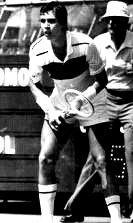 didn’t think it would be like that. I figured it would be two and a half hour or three hours. I just went in to change my clothes and the match was over.” The 20-year-old Lendl, seeded 10th, thrashed Solomon, seeded 7th, 6-1, 6-0, 6-0 in 1 hour 25 minutes, as a dazzling sun baked the crowd of 14,067. Lendl’s first advancement to a major quarterfinal. His victory over the normally steady Solomon was so swift and stunning that many observers assumed that Solomon was sick or injured. Solomon made no excuses: “After about the 2nd game, I didn’t feel I could move me feet. I didn’t feel like I had any get-and-go, so I got up and went”. Solomon, once the maven of moon balls who recently set out to develop a serve-and-volley game, stayed back and committed 26 forehand errors. “When I got on top” Lendl explained his amazing performance, “I said to myself ‘OK, let’s go and go’. I just tried to keep going the same way and it worked.” Solomon admitted: “Ivan is stronger than me. He was able to get more pace on the ball.” McEnroe, who beat Pascal Portes 6-2, 6-4, 6-2, said: “I’m starting to move better at the net. A few balls today I missed by intches.” On an afternoon when all losers were uncommonly gracious, Brian Gottfried echoed Portes’ sentiments. “If a guy plays better than you, you must say ‘Too good'” said Gottfried, after he had been beaten 6-4, 6-2, 6-1 by Eltiot Teltscher, and his sharp passing-shots. Bernard Mitton, who lost 6-7, 4-6, 4-6 to Jimmy Connors, was a game ahead until the tie-break and up a break in the second and third sets. Bjorn Borg showed no signs of his initial knee problems outplaying Yannick Noah 6-3, 6-3, 6-0 in 86 minutes. Johan Kriek and Wojtek Fibak won their matches in four sets.
didn’t think it would be like that. I figured it would be two and a half hour or three hours. I just went in to change my clothes and the match was over.” The 20-year-old Lendl, seeded 10th, thrashed Solomon, seeded 7th, 6-1, 6-0, 6-0 in 1 hour 25 minutes, as a dazzling sun baked the crowd of 14,067. Lendl’s first advancement to a major quarterfinal. His victory over the normally steady Solomon was so swift and stunning that many observers assumed that Solomon was sick or injured. Solomon made no excuses: “After about the 2nd game, I didn’t feel I could move me feet. I didn’t feel like I had any get-and-go, so I got up and went”. Solomon, once the maven of moon balls who recently set out to develop a serve-and-volley game, stayed back and committed 26 forehand errors. “When I got on top” Lendl explained his amazing performance, “I said to myself ‘OK, let’s go and go’. I just tried to keep going the same way and it worked.” Solomon admitted: “Ivan is stronger than me. He was able to get more pace on the ball.” McEnroe, who beat Pascal Portes 6-2, 6-4, 6-2, said: “I’m starting to move better at the net. A few balls today I missed by intches.” On an afternoon when all losers were uncommonly gracious, Brian Gottfried echoed Portes’ sentiments. “If a guy plays better than you, you must say ‘Too good'” said Gottfried, after he had been beaten 6-4, 6-2, 6-1 by Eltiot Teltscher, and his sharp passing-shots. Bernard Mitton, who lost 6-7, 4-6, 4-6 to Jimmy Connors, was a game ahead until the tie-break and up a break in the second and third sets. Bjorn Borg showed no signs of his initial knee problems outplaying Yannick Noah 6-3, 6-3, 6-0 in 86 minutes. Johan Kriek and Wojtek Fibak won their matches in four sets.
Quarterfinals:
Up on the scoreboard at the United States Open tennis championships yesterday, Bjorn Borg had lost the second and third sets to Roscoe Tanner and now he was trailing, 4:2, in the 4th. Staring out from under the navy blue and white headband around his long blond hair, he calmly bounced the ball twice, looked across the net and prepared to serve. ”I thought when it was 4:2,” he would say later, ”that it would be very, very difficult to win the match.” Difficult but not impossible. Difficult but yet it never occurred to Borg that he would lose. After his memorable Wimbledon final with John McEnroe almost two months ago, the Swede acknowledged that he actually thought once that he might not win. But yesterday he thought only that it would be ”very, very difficult” to win. In the end, of course, Borg won, 6-4, 3-6, 4-6, 7-5, 6-3, as he had to do if he is going to justify the adulation that he commands. As the Wimbledon champion for the last five years, the 24-year-old Swede, is being hailed by some tennis observers as perhaps the best tennis player ever – better than Bill Tilden, better than Rod Laver, better than Don Budge, better than Pancho Gonzales, better than anybody else. But until now Bjorn Borg has never won the United States Open, and until he does he cannot be considered the best tennis player ever. ”I don’t know that Bjorn played any better this year than he did last year,” Roscoe Tanner said, referring to his win over Borg in the US Open quarterfinals ’79. ”Change a couple of points and I win in four sets, which is what I did last year.” But this year Bjorn Borg won. This year, too, he played Tanner in the sunlight of a glorious golden afternoon instead of under artificial lights at night, as he did last year. When Borg, who has been top-seeded at the Open for the last four years, complained that he did not prefer to play at night, it did not change last year’s result. But it probably influenced yesterday’s scheduling. ”It’s more easy to play during the day,” Bjorn Borg agreed. ”At night the ball comes much faster at 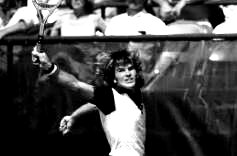 you.” Especially the ball as it comes off Tanner’s racquet. In their 15 matches, Borg has now won 11 but Tanner had beaten him twice on cement and once indoors in addition to last year’s upset on the DecoTurf stadium court at the National Tennis Center. ‘‘If he gets his first serve in all the time,” Borg said later of Tanner, ”there’s nothing you can do. But in the fourth set he started missing some first serves.” Borg’s next opponent, Johan Kriek won last night’s quarterfinal against Wojtek Fibak in five sets. The unseeded Kriek has become the phantom of the Open. After having won his third-round match from Sammy Giammalva by an injury default, the 22-year-old South African cramped against Buster Mottram in a controversial four-set battle, after which Mottram refused to shake hands. Last night, before a crowd of 16,143, Kriek won a lively, 3-hour-55-minute match from Fibak, coming from 2:5 in the fifth-set tiebreaker after the two had traded 18 service breaks. The scores were 6-4, 2-6, 6-3, 1-6, 7-6(5). For the 28-year-old Fibak, it was third quarterfinal defeat in Grand Slams of 1980, the fourth and last one in total (he had never been closer to get semifinals). Borg’s duel in the sun with Tanner, before a crowd of 15,509 lasted 2 hours, 53-minutes. The American left-handers, John McEnroe and Jimmy Connors survived four-set matches. McEnroe recovered after a shaky start and defeated Ivan Lendl 4-6, 6-3, 6-2, 7-5 last night. Earlier in the day, Connors used an effective lob to score a 6-1, 3-6, 6-3, 6-0 victory over Eliot Teltscher. McEnroe’s 2-hour, 47-minute victory was his strongest performance of the tournament. With
you.” Especially the ball as it comes off Tanner’s racquet. In their 15 matches, Borg has now won 11 but Tanner had beaten him twice on cement and once indoors in addition to last year’s upset on the DecoTurf stadium court at the National Tennis Center. ‘‘If he gets his first serve in all the time,” Borg said later of Tanner, ”there’s nothing you can do. But in the fourth set he started missing some first serves.” Borg’s next opponent, Johan Kriek won last night’s quarterfinal against Wojtek Fibak in five sets. The unseeded Kriek has become the phantom of the Open. After having won his third-round match from Sammy Giammalva by an injury default, the 22-year-old South African cramped against Buster Mottram in a controversial four-set battle, after which Mottram refused to shake hands. Last night, before a crowd of 16,143, Kriek won a lively, 3-hour-55-minute match from Fibak, coming from 2:5 in the fifth-set tiebreaker after the two had traded 18 service breaks. The scores were 6-4, 2-6, 6-3, 1-6, 7-6(5). For the 28-year-old Fibak, it was third quarterfinal defeat in Grand Slams of 1980, the fourth and last one in total (he had never been closer to get semifinals). Borg’s duel in the sun with Tanner, before a crowd of 15,509 lasted 2 hours, 53-minutes. The American left-handers, John McEnroe and Jimmy Connors survived four-set matches. McEnroe recovered after a shaky start and defeated Ivan Lendl 4-6, 6-3, 6-2, 7-5 last night. Earlier in the day, Connors used an effective lob to score a 6-1, 3-6, 6-3, 6-0 victory over Eliot Teltscher. McEnroe’s 2-hour, 47-minute victory was his strongest performance of the tournament. With 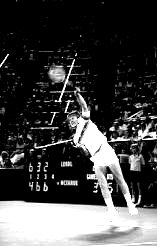 McEnroe making only 48 percent of his first serves, Lendl took the 1st set by controlling the tempo of their baseline rallies. Bu as McEnroe’s 1st-serve percentage improved, his serve-and-volley game became dominant. Even when Lendl had a break point for 3-all in the 3rd set and a double break point with McEnroe serving at 3:4, the American held service. McEnroe finished the mtach with 68 percent of his first serves, 9 aces and 15 service winners. “I wouldn’t be disappointed if I could pick up my game from the last two sets”. Connors led *3:0 in the 2nd set against Teltscher when the 21-year-old Californian sensationally managed to win six straight games forcing Connors to make errors from both wings. After having broken Teltscher for a 3:1 lead in the 3rd set, Connors opened his service game with a lob that Teltscher netted on a high backhand volley. Teltscher held a break point in that game, but Connors ripped a forehand cross-court passing-shot and never looked back.
McEnroe making only 48 percent of his first serves, Lendl took the 1st set by controlling the tempo of their baseline rallies. Bu as McEnroe’s 1st-serve percentage improved, his serve-and-volley game became dominant. Even when Lendl had a break point for 3-all in the 3rd set and a double break point with McEnroe serving at 3:4, the American held service. McEnroe finished the mtach with 68 percent of his first serves, 9 aces and 15 service winners. “I wouldn’t be disappointed if I could pick up my game from the last two sets”. Connors led *3:0 in the 2nd set against Teltscher when the 21-year-old Californian sensationally managed to win six straight games forcing Connors to make errors from both wings. After having broken Teltscher for a 3:1 lead in the 3rd set, Connors opened his service game with a lob that Teltscher netted on a high backhand volley. Teltscher held a break point in that game, but Connors ripped a forehand cross-court passing-shot and never looked back.
Semifinals:
John McEnroe outfought Jimmy Connors in a fifth-set tiebreaker yesterday and joined Bjorn Borg, another survivor in five sets, in the men’s singles final of the United States Open tennis  championships. In setting up an encore to their classic Wimbledon final, which Borg won in five close sets. Borg lost the first two sets of his semifinal yesterday to Johan Kriek before reaffirming his superiority in the fifth set for the 13th consecutive time. The scores were 4-6, 4-6, 6-1, 6-1, 6-1, and the victory again moved the 24-year-old Swede to within one match of his first Open singles crown in the third leg of the Grand Slam. Left-handers have won the last six men’s singles titles in the Open, and McEnroe, the 21-year-old defending champion, has been Borg’s stiffest challenger on the tour in recent years. The finest tribute to the 4-hour 16-minute duel between McEnroe and Connors was that almost all of the capacity crowd of 18,586, despite more than nine hours of continuous tennis, stayed until McEnroe served and won the last point in the tiebreaker. The scores were 6-4, 5-7, 0-6, 6-3, 7-6(3). While the Borg-Kriek opener in the Stadium produced interesting patches, particularly when Borg’s surprising two-handed backhand down the line changed the momentum of the match, the 14th meeting between McEnroe and Connors was another dizzy ride on a roller coaster. There were no verbal outbursts to rival their stormy Wimbledon semifinal, which McEnroe took in four sets. But between McEnroe’s dominant serve-and-volley games and Connors’s brilliant returns, a radiant sunset engulfed the Manhattan skyline. Wide-kicking serves kept Connors on the defensive, and McEnroe controlled the pace of baseline rallies as Connors struggled with a familiar problem, short shots in the middle of the court. But as Connors began to groove service returns, which have been the backbone of his game and helped bring him Open titles in 1974, 1976 and 1978, McEnroe grew unsettled. In rapid succession bullets came back at McEnroe’s feet and down the line. The more he struggled with second serves and first volleys, the slower McEnroe trudged to the service line, annoyed by spectators wandering in the aisles, planes overhead and the electronic eye that assists service linesmen. ”He just started returning incredible,” McEnroe said. Connors escaped a set point at 4:5 and 30/40 in the 2nd set when McEnroe, perhaps too casually, drove a forehand return long. Connors held from ‘deuce’ and then broke from deuce for 6:5 with a forehand cross-court pass and a backhand pass down the line. He held serve at ‘love’ for the set. McEnroe’s shots and mind drifted. If he had not settled himself while serving at 0:2 (0/30) in the 4th set, Connors might have run out the match. ”He started missing a few balls,” McEnroe said, ”and that let me back in the match.” The 5th set produced the best shot-making of the tournament. After breaking Connors from ‘deuce’ for 3:2, McEnroe served for the match at 5:4 only to have Connors break back in another ‘deuce’ struggle with successive backhand return winners. By the time the two Americans reached the decisive tiebreaker, the 28-year-old Connors seemed almost too pumped up. Instead of trying to steady himself, he went for low-percentage shots, playing the only way he has known. An over-the-shoulder drive left Connors vulnerable to McEnroe’s volley on the first point. Connors netted a forehand volley and then drove a backhand long when McEnroe skillfully changed speeds, slowing his return. A backhand cross-court hit the tape and sailed wide, putting McEnroe safely in control, 5:1. Whether McEnroe can rebound from the marathon Connors match, the strain of a strenuous fourth-set quarterfinal match against Ivan Lendl and the five-set men’s doubles final on Friday, could determine how well he will be able to apply pressure to Borg. ”If I’m stiff tomorrow,” McEnroe said, ”that’s going to present heavy-duty problems.” Borg already has won the French and Wimbledon crowns this year, with the Australian as the final leg of the Grand Slam in late December. For two sets yesterday, however, the unseeded
championships. In setting up an encore to their classic Wimbledon final, which Borg won in five close sets. Borg lost the first two sets of his semifinal yesterday to Johan Kriek before reaffirming his superiority in the fifth set for the 13th consecutive time. The scores were 4-6, 4-6, 6-1, 6-1, 6-1, and the victory again moved the 24-year-old Swede to within one match of his first Open singles crown in the third leg of the Grand Slam. Left-handers have won the last six men’s singles titles in the Open, and McEnroe, the 21-year-old defending champion, has been Borg’s stiffest challenger on the tour in recent years. The finest tribute to the 4-hour 16-minute duel between McEnroe and Connors was that almost all of the capacity crowd of 18,586, despite more than nine hours of continuous tennis, stayed until McEnroe served and won the last point in the tiebreaker. The scores were 6-4, 5-7, 0-6, 6-3, 7-6(3). While the Borg-Kriek opener in the Stadium produced interesting patches, particularly when Borg’s surprising two-handed backhand down the line changed the momentum of the match, the 14th meeting between McEnroe and Connors was another dizzy ride on a roller coaster. There were no verbal outbursts to rival their stormy Wimbledon semifinal, which McEnroe took in four sets. But between McEnroe’s dominant serve-and-volley games and Connors’s brilliant returns, a radiant sunset engulfed the Manhattan skyline. Wide-kicking serves kept Connors on the defensive, and McEnroe controlled the pace of baseline rallies as Connors struggled with a familiar problem, short shots in the middle of the court. But as Connors began to groove service returns, which have been the backbone of his game and helped bring him Open titles in 1974, 1976 and 1978, McEnroe grew unsettled. In rapid succession bullets came back at McEnroe’s feet and down the line. The more he struggled with second serves and first volleys, the slower McEnroe trudged to the service line, annoyed by spectators wandering in the aisles, planes overhead and the electronic eye that assists service linesmen. ”He just started returning incredible,” McEnroe said. Connors escaped a set point at 4:5 and 30/40 in the 2nd set when McEnroe, perhaps too casually, drove a forehand return long. Connors held from ‘deuce’ and then broke from deuce for 6:5 with a forehand cross-court pass and a backhand pass down the line. He held serve at ‘love’ for the set. McEnroe’s shots and mind drifted. If he had not settled himself while serving at 0:2 (0/30) in the 4th set, Connors might have run out the match. ”He started missing a few balls,” McEnroe said, ”and that let me back in the match.” The 5th set produced the best shot-making of the tournament. After breaking Connors from ‘deuce’ for 3:2, McEnroe served for the match at 5:4 only to have Connors break back in another ‘deuce’ struggle with successive backhand return winners. By the time the two Americans reached the decisive tiebreaker, the 28-year-old Connors seemed almost too pumped up. Instead of trying to steady himself, he went for low-percentage shots, playing the only way he has known. An over-the-shoulder drive left Connors vulnerable to McEnroe’s volley on the first point. Connors netted a forehand volley and then drove a backhand long when McEnroe skillfully changed speeds, slowing his return. A backhand cross-court hit the tape and sailed wide, putting McEnroe safely in control, 5:1. Whether McEnroe can rebound from the marathon Connors match, the strain of a strenuous fourth-set quarterfinal match against Ivan Lendl and the five-set men’s doubles final on Friday, could determine how well he will be able to apply pressure to Borg. ”If I’m stiff tomorrow,” McEnroe said, ”that’s going to present heavy-duty problems.” Borg already has won the French and Wimbledon crowns this year, with the Australian as the final leg of the Grand Slam in late December. For two sets yesterday, however, the unseeded 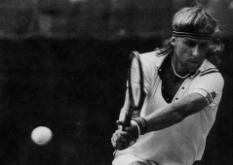 21-year-old Kriek was unimpressed, playing with the same intensity that characterized surprising triumphs over ninth-seeded Peter Fleming, Buster Mottram and Wojtek Fibak. Borg managed only five points in Kriek’s first five service games and committed 14 service-return errors in the opening two sets, unable to find a rhythm for handling Kriek’s wide-kicking serves in the deuce court or his volleys. Kriek, hardly a household word on the men’s tour, is a South African who now lives in Naples, and is 29th on the computer rankings. But something seems to ignite his game in the Open; he reached the quarterfinals the last two years and the semifinals this year, a virtual phantom while beating Mottram in four sets and Fibak in another long late-night match that went to a fifth-set tiebreaker. At 5 feet 7, 1/2 inches, Kriek hardly fits the role of a giant. But his flat and kick serves are weapons that most 6-footers would envy. He can volley with touch, angle and depth, and his ground strokes are particularly effective on the hard courts that are common in South Africa and now are the surface in the Open. But finishing Borg in a three-of-five-set format can be frustrating, as Roscoe Tanner learned in the quarterfinals, after leading Borg, two sets to one and 4:2 in the 4th. Borg changed the momentum by breaking Kriek to open the 3rd set and escaped from deuce on serve to 2:0 and from 0/30 to 3:1, even as Lennart Bergelin, his coach, was muttering in a court-side box that Borg was ”somewhere else” during the match. Kriek’s last stand came in the 2nd game of the 4th set after he had broken Borg in the opening game. He reached 30-all with an angled backhand volley but succumbed to more of Borg’s service-return magic, particularly a backhand down the line that often is overlooked in the two-handed repertory because it requires such delicate readjustments in footwork and body position. Kriek, anticipating Borg’s backhand cross-court, wound up being stretched and beaten down the line. ”I wanted to get to the volley before I hit the serve,” he said. Borg has not lost a match in the fifth set since 1976. Kriek was never closer than 30-all in Borg’s three service games. ”When it comes to the fifth set,” said Borg, who won after trailing two sets to none for the fifth time in a match since 1974, ”it’s a lot of pressure, a lot of nerves. Guys don’t play as relaxed, maybe they don’t play the approach shot as well. They’re a little scared to hit through.” Kriek had talked boldly, almost defiantly, of challenging Borg: ”I though I was going to win, and that’s why I lost.” For Kriek it was first 5-set defeat after three wins, he ended his career as the biggest specialist of 5-set matches beside Borg with an 18-4 record!
21-year-old Kriek was unimpressed, playing with the same intensity that characterized surprising triumphs over ninth-seeded Peter Fleming, Buster Mottram and Wojtek Fibak. Borg managed only five points in Kriek’s first five service games and committed 14 service-return errors in the opening two sets, unable to find a rhythm for handling Kriek’s wide-kicking serves in the deuce court or his volleys. Kriek, hardly a household word on the men’s tour, is a South African who now lives in Naples, and is 29th on the computer rankings. But something seems to ignite his game in the Open; he reached the quarterfinals the last two years and the semifinals this year, a virtual phantom while beating Mottram in four sets and Fibak in another long late-night match that went to a fifth-set tiebreaker. At 5 feet 7, 1/2 inches, Kriek hardly fits the role of a giant. But his flat and kick serves are weapons that most 6-footers would envy. He can volley with touch, angle and depth, and his ground strokes are particularly effective on the hard courts that are common in South Africa and now are the surface in the Open. But finishing Borg in a three-of-five-set format can be frustrating, as Roscoe Tanner learned in the quarterfinals, after leading Borg, two sets to one and 4:2 in the 4th. Borg changed the momentum by breaking Kriek to open the 3rd set and escaped from deuce on serve to 2:0 and from 0/30 to 3:1, even as Lennart Bergelin, his coach, was muttering in a court-side box that Borg was ”somewhere else” during the match. Kriek’s last stand came in the 2nd game of the 4th set after he had broken Borg in the opening game. He reached 30-all with an angled backhand volley but succumbed to more of Borg’s service-return magic, particularly a backhand down the line that often is overlooked in the two-handed repertory because it requires such delicate readjustments in footwork and body position. Kriek, anticipating Borg’s backhand cross-court, wound up being stretched and beaten down the line. ”I wanted to get to the volley before I hit the serve,” he said. Borg has not lost a match in the fifth set since 1976. Kriek was never closer than 30-all in Borg’s three service games. ”When it comes to the fifth set,” said Borg, who won after trailing two sets to none for the fifth time in a match since 1974, ”it’s a lot of pressure, a lot of nerves. Guys don’t play as relaxed, maybe they don’t play the approach shot as well. They’re a little scared to hit through.” Kriek had talked boldly, almost defiantly, of challenging Borg: ”I though I was going to win, and that’s why I lost.” For Kriek it was first 5-set defeat after three wins, he ended his career as the biggest specialist of 5-set matches beside Borg with an 18-4 record!
Final:

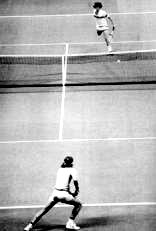 What an encore! John McEnroe beat Bjorn Borg in five sets yesterday for his second consecutive singles title at the United States Open tennis championships. Two months after their five-set Wimbledon classic, which might have been the best men’s final ever, the sport’s top two pros traded firepower for 4 hours 13 minutes at the National Tennis Center. This time McEnroe won, 7-6(4), 6-1, 6-7(5), 5-7, 6-4, frustrating Borg’s bid for his first Open crown and a Grand Slam sweep of the four major championships. The match may have lacked Wimbledon’s fourth-set tiebreaker intensity and fifth-set drama in the minds of the players. But it had the same number of total games, 55; two tense tiebreakers and was especially noteworthy for McEnroe’s amazing stamina. He had struggled to a five-set semifinal victory over Jimmy Connors on Saturday night that lasted 4 hours 16 minutes and went to a decisive tiebreaker. Few athletes have been subjected to such stress under championship conditions. That McEnroe survived, after admitting that ”I thought my body was going to fall off” after the fourth set, was the strongest tribute to credentials often lost in his courtside conduct.. McEnroe won $46,000. But the top prize seemed almost secondary to a situation that saw the top-seeded Borg beaten in the fifth set for the first time in 14 matches, a span that had covered four years. It capped a tournament that, like Wimbledon, began slowly with the early emphasis on weather, but wound up in a blaze of glorious matches. Borg had fought back from deficits earlier in the tournament and won five-set matches against Roscoe Tanner in the quarterfinals and Johan Kriek in the semifinals. But he did not serve with the consistency or force that had helped him win 19 points in a row on serve against McEnroe in the fifth set of their Wimbledon final, which Borg won 8-6 in the 5th set. Borg twice served for the first set, at 5:4 and 6:5, but was broken each time, the second time at love. After he had lost the first-set tiebreaker, with McEnroe attacking his serve and putting away forehand volleys, Borg’s mind, spirit and first serves drifted. ”I don’t know what happened in the second set,’‘ he said of the span in which McEnroe ran off 13 points between the first and fourth games. ‘‘I didn’t have any feel for the ball.” Ahead, two sets to love, McEnroe was aware of his good fortune. But as Borg struggled and held serve from 0/30 to 1-all in the 3rd set and from 15/30 to 2-all, the Douglaston, Queens, left-hander knew that Borg was down, but not out. ”He gets you in that lull,” McEnroe said of Borg’s ability to rebound when it appeared that he had given up. ”Then you start going around slower and he wins a set. You don’t think he’s trying, but he’s trying to find a way to get his game back together.” Borg found a way with backhand winners down the line that opened and closed the third-set tiebreaker. When McEnroe, serving at 5:6 in the 4th set, started guessing that Borg would try to hit down the line, Borg instead went crosscourt with the backhand, broke for the only time in the set and evened the match. ”I thought I had a good chance, especially when it came to the fifth set,” Borg said. The fifth set has been Borg’s sanctuary, in which he has had some of his most majestic moments as a five-time Wimbledon and French Open champion. The last time he lost a match in the fifth set was four years ago (WCT Challenge Cup to Ilie Nastase, also 4-6 in the 5th set). McEnroe’s first-serve percentage in the fifth set was 70, which allowed him to move in for decisive first volleys. By contrast, Borg faulted 14 of his 29 first serves and double-faulted twice in the 7th game, which he lost from deuce on McEnroe’s backhand lob and his own netted forehand volley. ”I think I lost the match because I wasn’t serving well,” Borg said, unable to determine whether his problem came from the toss or a lack of rhythm. The thought of McEnroe ready and eager to rush the net could not have helped Borg’s concentration. Both carved the lines like surgeons, creating several controversial points for the five linesmen, half the number utilized at Wimbledon. In the final few games, however, McEnroe’s wide-sweeping southpaw serve was the dominant weapon, extending the reign of left-handed men’s champions in the world’s richest tournament to seven consecutive
What an encore! John McEnroe beat Bjorn Borg in five sets yesterday for his second consecutive singles title at the United States Open tennis championships. Two months after their five-set Wimbledon classic, which might have been the best men’s final ever, the sport’s top two pros traded firepower for 4 hours 13 minutes at the National Tennis Center. This time McEnroe won, 7-6(4), 6-1, 6-7(5), 5-7, 6-4, frustrating Borg’s bid for his first Open crown and a Grand Slam sweep of the four major championships. The match may have lacked Wimbledon’s fourth-set tiebreaker intensity and fifth-set drama in the minds of the players. But it had the same number of total games, 55; two tense tiebreakers and was especially noteworthy for McEnroe’s amazing stamina. He had struggled to a five-set semifinal victory over Jimmy Connors on Saturday night that lasted 4 hours 16 minutes and went to a decisive tiebreaker. Few athletes have been subjected to such stress under championship conditions. That McEnroe survived, after admitting that ”I thought my body was going to fall off” after the fourth set, was the strongest tribute to credentials often lost in his courtside conduct.. McEnroe won $46,000. But the top prize seemed almost secondary to a situation that saw the top-seeded Borg beaten in the fifth set for the first time in 14 matches, a span that had covered four years. It capped a tournament that, like Wimbledon, began slowly with the early emphasis on weather, but wound up in a blaze of glorious matches. Borg had fought back from deficits earlier in the tournament and won five-set matches against Roscoe Tanner in the quarterfinals and Johan Kriek in the semifinals. But he did not serve with the consistency or force that had helped him win 19 points in a row on serve against McEnroe in the fifth set of their Wimbledon final, which Borg won 8-6 in the 5th set. Borg twice served for the first set, at 5:4 and 6:5, but was broken each time, the second time at love. After he had lost the first-set tiebreaker, with McEnroe attacking his serve and putting away forehand volleys, Borg’s mind, spirit and first serves drifted. ”I don’t know what happened in the second set,’‘ he said of the span in which McEnroe ran off 13 points between the first and fourth games. ‘‘I didn’t have any feel for the ball.” Ahead, two sets to love, McEnroe was aware of his good fortune. But as Borg struggled and held serve from 0/30 to 1-all in the 3rd set and from 15/30 to 2-all, the Douglaston, Queens, left-hander knew that Borg was down, but not out. ”He gets you in that lull,” McEnroe said of Borg’s ability to rebound when it appeared that he had given up. ”Then you start going around slower and he wins a set. You don’t think he’s trying, but he’s trying to find a way to get his game back together.” Borg found a way with backhand winners down the line that opened and closed the third-set tiebreaker. When McEnroe, serving at 5:6 in the 4th set, started guessing that Borg would try to hit down the line, Borg instead went crosscourt with the backhand, broke for the only time in the set and evened the match. ”I thought I had a good chance, especially when it came to the fifth set,” Borg said. The fifth set has been Borg’s sanctuary, in which he has had some of his most majestic moments as a five-time Wimbledon and French Open champion. The last time he lost a match in the fifth set was four years ago (WCT Challenge Cup to Ilie Nastase, also 4-6 in the 5th set). McEnroe’s first-serve percentage in the fifth set was 70, which allowed him to move in for decisive first volleys. By contrast, Borg faulted 14 of his 29 first serves and double-faulted twice in the 7th game, which he lost from deuce on McEnroe’s backhand lob and his own netted forehand volley. ”I think I lost the match because I wasn’t serving well,” Borg said, unable to determine whether his problem came from the toss or a lack of rhythm. The thought of McEnroe ready and eager to rush the net could not have helped Borg’s concentration. Both carved the lines like surgeons, creating several controversial points for the five linesmen, half the number utilized at Wimbledon. In the final few games, however, McEnroe’s wide-sweeping southpaw serve was the dominant weapon, extending the reign of left-handed men’s champions in the world’s richest tournament to seven consecutive 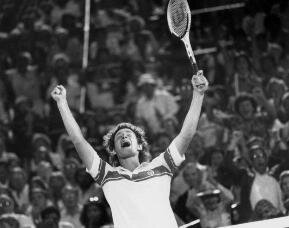 years. Serving at 4:3, McEnroe held at 15. Three of the points were won on serves, the fourth on a backhand volley placement. Borg held at love, thus forcing McEnroe to serve out the match, in the tradition of a champion. On Saturday night, Connors had broken McEnroe’s serve at 5:4 in the fifth set to send the match into the decisive tiebreaker, which McEnroe. At 5:4 against the Swede, McEnroe won the first point when Borg’s short cross-court backhand dropped inches wide. McEnroe drove a high forehand volley long, but reached 30/15 with a service winner deep to the backhand that Borg could only lift straight in the air. Two forehand volleys clinched the match. ”The intensity was higher at Wimbledon,” McEnroe said afterward, calling the title he had won the most satisfying of his career. ”There was consistency today, but I don’t think Bjorn played that well through the whole match.” ”The Wimbledon match was much better,” Borg said. ”John can play better, I can play better.” Perhaps. But McEnroe’s achievement reflected his ability to sustain an extraordinary level of excellence over a demanding stretch. On Thursday night, he ousted Ivan Lendl, one of the tour’s hottest players, in a long four-set battle. On Friday, he was back on the court in the men’s doubles final and lost in five sets. Then came Connors and Borg. ”I felt better here than at Wimbledon in the fifth set,” he said. McEnroe’s 20th title (2nd major). Stats of the final
years. Serving at 4:3, McEnroe held at 15. Three of the points were won on serves, the fourth on a backhand volley placement. Borg held at love, thus forcing McEnroe to serve out the match, in the tradition of a champion. On Saturday night, Connors had broken McEnroe’s serve at 5:4 in the fifth set to send the match into the decisive tiebreaker, which McEnroe. At 5:4 against the Swede, McEnroe won the first point when Borg’s short cross-court backhand dropped inches wide. McEnroe drove a high forehand volley long, but reached 30/15 with a service winner deep to the backhand that Borg could only lift straight in the air. Two forehand volleys clinched the match. ”The intensity was higher at Wimbledon,” McEnroe said afterward, calling the title he had won the most satisfying of his career. ”There was consistency today, but I don’t think Bjorn played that well through the whole match.” ”The Wimbledon match was much better,” Borg said. ”John can play better, I can play better.” Perhaps. But McEnroe’s achievement reflected his ability to sustain an extraordinary level of excellence over a demanding stretch. On Thursday night, he ousted Ivan Lendl, one of the tour’s hottest players, in a long four-set battle. On Friday, he was back on the court in the men’s doubles final and lost in five sets. Then came Connors and Borg. ”I felt better here than at Wimbledon in the fifth set,” he said. McEnroe’s 20th title (2nd major). Stats of the final
*****************************

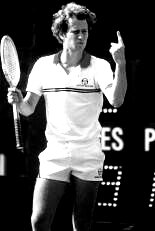
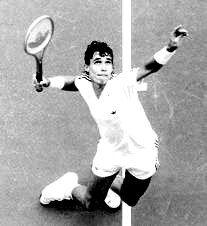
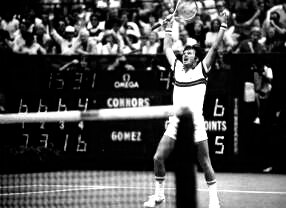
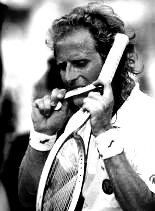
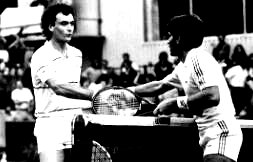

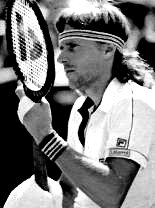
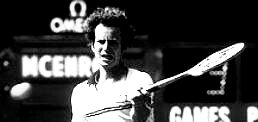
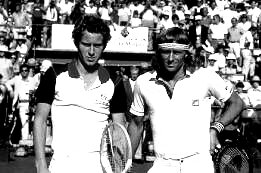
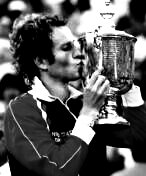
Fantastic specially the piece on my countryman Juan Nuñez.
YT films:
1980
McEnroe vs. Connors
McEnroe vs. Borg
1981
McEnroe vs. Gerulaitis
McEnroe vs. Borg (Italian)